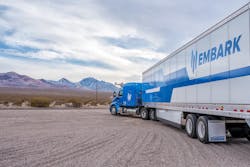Embark said its automated trucks traveled 124,062 miles during 2018, and drivers in those vehicles only needed to disengage the system, on average, once every 1,392 miles.
The company issued the public report covering its Level 2 automated fleet on Jan. 30, even though it is not required by law in its home state of California. The California Department of Motor Vehicles requires companies testing higher levels of automated vehicles to file a report annually.
“We are publicly releasing comparable disengagement data for 2018 because we believe transparency is a critical part of earning the public’s trust,” said Embark CEO Alex Rodrigues.
Embark said it is only the third company to top 100,000 automated miles in a year, joining Cruise, which is owned by General Motors, in 2017, and Google’s self-driving car project starting in 2015.
“By focusing on trucks on highways we’ve been able to safely progress towards commercialization much more quickly and cost-effectively,” Rodrigues said.
During 2018, Embark completed a coast-to-coast trip across the United States with an automated truck. The 2,400-mile journey went along Interstate 10 from Los Angeles to Jacksonville, FL.
The company continues to move freight for real customers, and there is always a driver behind the wheel.
Jonny Morris, Embark’s head of public policy, told Fleet Owner the automated system could potentially be disengaged and re-engaged multiple times during a long trip.
As an example, he said a truck driver could choose to disengage prior to merging into traffic, and then switch back into automated mode once appropriate.
Morris declined to share the exact number of trucks in Embark’s fleet, but said the company was planning to add more vehicles moving forward.
About the Author
Neil Abt
Neil Abt is a former FleetOwner editor who wrote for the publication from 2017 to 2020. He was editorial director from 2018 to 2020.
